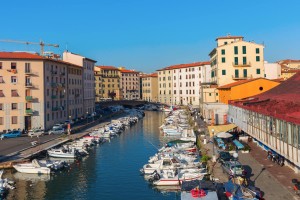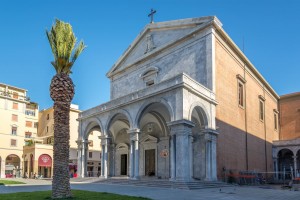Tuscany’s cities of arts are widely known for their wealth, their astonishing abundance of sights and secret treasures as well as for their eventful, exciting history full of ups and downs. Livorno, however, slightly breaks what seems to be the regional precedent. The capital of the eponymous province served as a sort of suburb and defensive fortification for several centuries, blossomed only very late as a free port and centre of trade, only to be destroyed and at least mostly rebuilt with a lot of effort. Nowadays, the city of arts Livorno invites you to go on extended tours with numerous hidden gems, with wide and open squares, and with a hint of Venice – very unusual, very attractive. And most definitely the perfect destination for your next city holiday.
The ideal town and its free port
The area around Livorno attracted settlers from very early on thanks to its ideal coastal location. Neolithic discoveries attest to it. The Romans settled near today’s port during the construction of Via Aurelia and likely named the settlement after “liburna”, a type of warship. However, it took until the year 1017 for the first documented mention of Livorno (as Livorna). The small coastal village later fell to the maritime Republic of Pisa, served as an important fishing village and defensive site, and eventually expanded its maritime position when Pisa’s port sanded up. Destroyed several times during battles, Livorno ultimately became part of Florence in 1421.
The city blossomed during the Medici reign. Livorno was seen as a key access point to the sea leading to several extensions of the port with fortifications following soon after. It took until 1571 when the Grand Dukes Cosimo I and Francesco I decided to have Livorno made into an “ideal town”. Rectangular roads still run through the historic centre. The Leggi Livornine decree that assured religious freedom and various privileges to all merchants regardless of origin slowly turned Livorno into a multicultural and multireligious town. It blossomed after the free port declaration in 1657 lasting until the incorporation into the Kingdom of Italy. Brutally devastated by air raids during the Second World War and not fully rebuilt to this day, the restructured modern Livorno has since become a city of tourism. The port is still among the most important ones in all of Italy.
Venezia Nuova and the defensive fortifications

©Bigstock.com/Madrabothair
Livorno lost a lot of its original building fabrics due to the massive destruction in the Second World War. However, you can still easily spot the old Medici city layout. It consists of several large military defensive fortifications and an entire district that cleverly enhanced Bernardo Buontalenti’s concept of a pentagonal ideal town (the so-called “Pentagono del Buontalenti”) and took it to a new level. Here are some cornerstones:
- Venezia Nuova: Grand Duke Ferdinano II de’ Medici seized the opportunity to expand the city northward in 1629. Venezia Nuova was established to grant more space to the port area and the flourishing trade. As the name suggests the construction of the new rione was inspired by Venice creating a network of houses and canals for which Venetian experts were imported. The narrow roads, numerous bridges and many canals lend themselves to delightful explorations.
- Fortezza Vecchia: Venezia Nuova was supposed to be connected to the city’s old defensive fortifications and Fortezza Vecchia is the oldest of them all. Built around a massive tower from the year 1077, the Pisans initially created a large fortress that was later expanded by the Medici who even had a palace added to it. The extensively renovated facility now mainly serves as an event centre.
- Fortezza Nuova: Grand Duke Cosimo I had two old bastions converted into the new fortress. It was modified considerably starting in 1590 and expanded to form the grand Fortezza Nuova made to protect the new district Venezia Nuova. The facility currently houses a large park.
Squares and palaces
Being an ideal town, Livorno isn’t just home to many old buildings – partially heavily modernised out of necessity – but also to many squares with great historic significance and magical palaces as gripping eye-catcher. And you certainly wouldn’t want to miss out on any of them.
- Piazza della Repubblica: There came a time when the old Pentagono del Buontalenti simply wasn’t enough anymore. Livorno had to grow and gained new districts in the east. A new square established in 1844 connected old and new structures even spanning the canal structure. There’s something genuinely magical to Piazza della Repubblica with its 52 marble benches, 92 pillars and various statues.
- Terrazza Mascagni: The first structure along the shore belvedere Viale Italia were built as early as during the Medici reign and saw several reconstructions that eventually turned it into a seaside terrace. As such, you’ll certainly be wowed by the view of the sea and the hills of Livorno during your walk – perfect to kick back and get away from it all.
- Palazzo Comunale: One of the oldest palaces of the city still in existence dates back to, you guessed it, the Medici, but construction only began in 1720 with multiple expansions in later years. The neo-Renaissance palace on Piazza d’Arme served as a meeting place for the city’s various representatives and “absorbed” additional buildings in later years including an old fire station.
Even more sights in Livorno

©Bigstock.com/milosk50
Wait, that’s already it? Heck to the no! We still have a few more select beauties you definitely should check out.
- Duomo di Livorno: This cathedral dedicated to Francis of Assisi and other sains was built in the heart of the old city, on Piazza Grande, between 1594 and 1606. Originally conceived as a church, it was expanded into a Duomo with a tall tower during the early 19th Most original plans were used for the reconstruction after the Second World War.
- Chiesa della Madonna: According to a legend this church between the old city and Venezia Nuova was built for a Carmelite statue. The various altars are genuine eye-catcher hidden behind a fairy plain façade that was covered with marble in 1972.
- Monumento dei quattro mori: The “Monument of the Four Moors” is one of Livorno’s most popular features. It consists of a stone statue of Grand Duke Ferdinand I surrounded by four chained-up pirates. Created after several naval battles against Barbary pirates, this monument was transported to a safe place during the Second World War.
- Cisternoni di Livorno: Three neoclassical building complexes constructed between 1829 to 1848 were established to ensure Livorno’s water supply (“cisternoni” means “great cisterns”). Cisternino di città near Fortezza Nuova looks like an antipole to the elegance of its time. However, it was never used as an actual cistern and is currently the home of a cultural centre.
Livorno is a special city in many respects. While the ancient roots have pretty much disappeared, you get to look forward to an unusual mix of Renaissance and neoclassical architecture with modern elements, to wide squares and fascinating canal structures. Livorno lends itself to long walks with great discoveries and many hidden treasures – a slightly different city of arts with a unique charm.